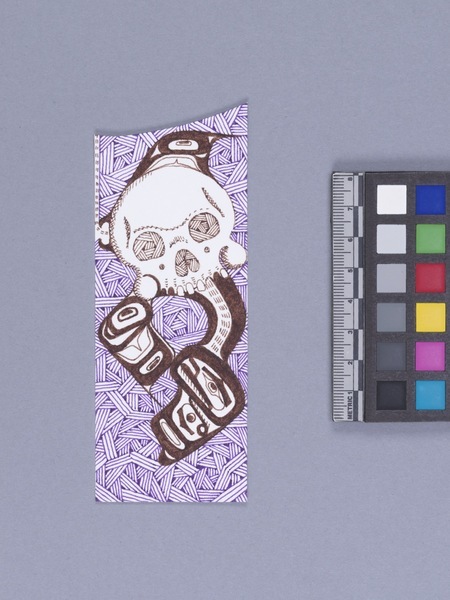Drawing Item Number: 3223/32 from the MOA: University of British Columbia

Description
A drawing of a skull on a single-sided piece of paper. The top edge of the paper curves upwards; the right edge of the paper is longer than the left edge. The background of the drawing is decorated with criss-crossing assemblages of purple line patterns in varying thicknesses. In the forefront, a human skull is outlined in purple ink; the interior of the skull is white. The nasal and eye cavities of the skull are filled in with small crisscrossing assemblages of purple line patterns. An underlying dorsal fin extends from the top of the skull; a blowhole is drawn on the left side of the skull. Extending outwards from the upper jaw of the skull are two fins. The left fin is positioned just below the skull and is decorated with two ovoids. The right fin, drawn at the end of an appendage with a line pattern decorating the interior, is embellished by two creatures. The reverse-side of the drawing is blank.
History Of Use
These 62 small works (3223/1-62) comprise a collection of drawings in pencil, ink, pencil crayon, and felt pen made by the artist between the years 1968 and 2015. During that period the artist has identified himself by the following names: Ron Hamilton; Hupquatchew; Ki-ke-in; Kwayatsapalth; Chuuchkamalthnii; and Haa’yuups. The drawings are, for the most part, applied to the backs of bookmarks acquired from a range of bookshops; some are applied to other pieces of paper or cutouts from his earlier silkscreen prints. Many of the images represent killer whales, often in conjunction with accoutrements and symbols of Nuu-chah-nulth whaling. The juxtaposition of bookmark and representation of Nuu-chah-nulth himwits’a, or narrative, is a deliberate and meaningful placement of two distinct knowledge systems in relationship with one another. Ephemeral drawings like these were not created for the market; the artist has long made them for himself and sometimes as gifts for relatives and friends; they are a way of sharing his knowledge and experience about Nuu-chah-nulth ways of knowing, thinking about, and being in this world; they are expressive of what he calls kiitskiitsa: marks made with intention.
Item History
- Made by Ron Hamilton (Maker) in British Columbia, Canada between 1968 and 2015
- Owned by Ron Hamilton before November 8, 2016
- Received from Museum of Anthropology Acquisitions Budget (Funding source), Michael O'Brian Family Foundation (Funding source) and Ron Hamilton (Seller) on November 18, 2016
What
- Name
- Drawing
- Identification Number
- 3223/32
- Type of Item
- drawing
- Overall
- height 13.1 cm, width 5.0 cm
Who
- Culture
- Nuu-chah-nulth: Hupacasath
- Creator
- Ron Hamilton (Maker)
- Previous Owner
- Ron Hamilton
- Received from
- Museum of Anthropology Acquisitions Budget (Funding source), Michael O'Brian Family Foundation (Funding source) and Ron Hamilton (Seller)
Where
- Holding Institution
- MOA: University of British Columbia
- Made in
- British Columbia, Canada
When
- Creation Date
- between 1968 and 2015
- Ownership Date
- before November 8, 2016
- Acquisition Date
- on November 18, 2016
Other
- Item Classes
- works on paper
- Condition
- excellent
- Accession Number
- 3223/0032